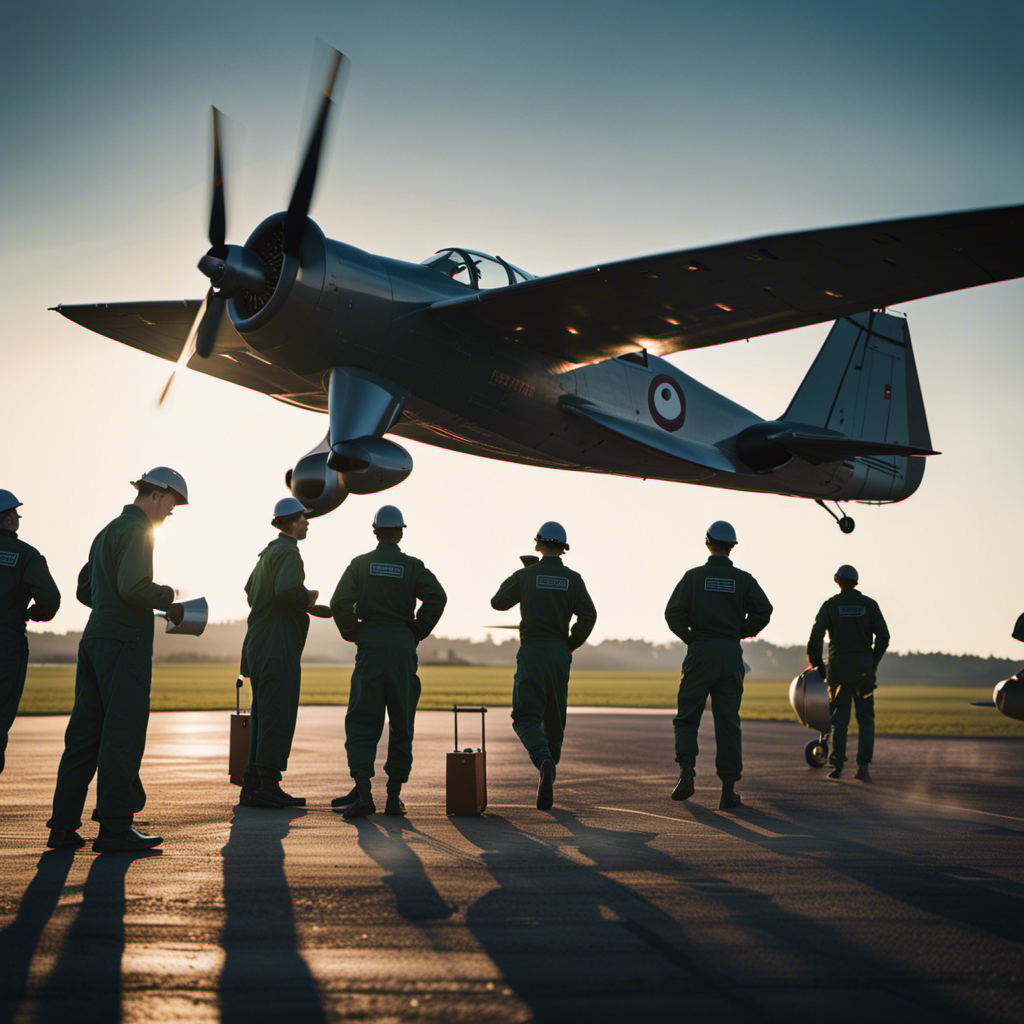As a glider pilot, I have always been amazed by the grace and beauty of flight. But one key factor that is often overlooked in every successful glider flight is the crucial role played by an unsung hero: aero towing.
Aero towing, the method of using a powered aircraft to tow gliders into the air, is a vital technique that allows gliders to reach the heights they need to truly soar.
In this article, we will explore the basics, history, mechanics, and advantages of aero towing, as well as its role in competition gliding and future developments.
So buckle up, because we’re about to take flight into the fascinating world of aero towing.
Key Takeaways
- Advancements in electric and hybrid technologies can reduce the carbon footprint in aero towing, contributing to a more sustainable and eco-friendly operation.
- Effective communication and safety measures are crucial in aero towing to ensure a smooth and safe launch, with constant coordination between pilots and tow plane operators.
- Aero towing offers increased accessibility and cost-effectiveness for gliders, allowing a wider range of enthusiasts to participate in gliding activities.
- Aero towing provides enhanced safety, a controlled and stable launch, and increased range for gliders, enhancing the overall gliding experience.
The Basics of Aero Towing
Aero towing is the most common method of getting gliders into the air. It involves a powered aircraft, called the tow plane, towing the glider behind it until it reaches the desired altitude.
Aero towing techniques vary depending on factors such as wind conditions and the weight of the glider. The tow rope used is typically made of strong, lightweight materials like nylon or dyneema. It is attached to both the tow plane and the glider using specialized aero towing equipment.
The pilot of the glider must maintain a steady position behind the tow plane, using control inputs to adjust the altitude and maintain the correct position in relation to the tow plane.
With these aero towing techniques and equipment, gliders can be safely and efficiently launched into the sky.
Now, let’s delve into the fascinating history of aero towing.
The History of Aero Towing
You may be interested to know that the history of towing gliders with airplanes dates back to the early 1900s. Over the years, aero towing techniques have evolved, leading to safer and more efficient methods of getting gliders into the air. Let’s take a look at the timeline of this evolution:
| Year | Evolution of Aero Towing Techniques | Famous Aero Tow Incidents |
|---|---|---|
| 1903 | First recorded glider towed by a powered aircraft | None |
| 1920s | Introduction of winch launching for gliders | None |
| 1940s | Adoption of multiple rope towing for increased safety | None |
| 1960s | Invention of the auto-release tow hitch for easier glider release | None |
Throughout history, there have been notable incidents during aero tows. One such incident occurred in 2003 when a towline snapped during a glider launch, causing the glider to crash. These incidents have led to continuous improvements in aero towing safety protocols.
With a brief understanding of the history of aero towing, let’s delve into the mechanics of this fascinating process.
The Mechanics of Aero Towing
Let’s explore how the mechanics of aero towing work and how gliders are connected to the towing aircraft.
Aero towing is a method used to launch gliders into the air using a powered aircraft. The physics behind aero towing involves the interaction between the glider and the towing aircraft.
A tow rope is attached to the glider’s nose or a tow hook, which is connected to the glider’s fuselage. The equipment used in aero towing includes a strong tow rope made of synthetic fibers and a tow release mechanism that allows for a controlled release of the glider once it reaches the desired altitude.
This method relies on the power of the towing aircraft to generate enough lift for both the glider and itself. The advantages of aero towing will be discussed in the next section.
The Advantages of Aero Towing
To fully appreciate the benefits of aero towing, consider the increased efficiency and cost-effectiveness it offers. Aero towing allows gliders to be launched into the air using a powered aircraft, eliminating the need for winches or ground-based launch systems. This method ensures a smooth takeoff, reducing the risk of damage to the glider and providing a more reliable launch experience.
Additionally, aero towing allows for longer and higher flights, as the glider can be towed to higher altitudes where thermals and updrafts are more prevalent. This increases the glider’s range and allows pilots to explore new areas and take on longer cross-country flights.
The efficiency of aero towing also translates into cost savings, as it requires less maintenance and equipment compared to traditional launch methods.
With these benefits in mind, let’s delve into the training and certification required for aero towing.
Training and Certification for Aero Towing
Pilots who want to engage in aero towing must undergo specialized training and obtain the necessary certifications. The training challenges in aero towing are unique and require a thorough understanding of both towing procedures and glider operations.
Pilots must learn how to safely connect and release the tow cable, maintain proper airspeed during the tow, and handle emergency situations. Additionally, they must be knowledgeable about the aerodynamics of towing and the limitations of the tow aircraft.
The certification process involves written exams, flight tests, and a demonstration of the pilot’s ability to handle various towing scenarios. It is a rigorous process that ensures pilots are well-prepared for the challenges they may face during aero towing.
Transitioning into the next section, it is important to understand the challenges and risks involved in this type of flying.
Challenges and Risks in Aero Towing
The challenges and risks in aero towing can be mitigated through proper training and certification. Safety measures are crucial in ensuring a smooth and secure towing operation. Pilots must be trained to handle unexpected situations such as sudden wind changes or equipment malfunctions.
Regular maintenance of the towing aircraft and the tow rope is essential to minimize the risk of accidents. Additionally, environmental impact is an important consideration in aero towing. Operators should adhere to strict guidelines to protect natural habitats and minimize noise pollution.
Aero Towing in Competition Gliding
Competitors often rely on aero towing as a quick and efficient method of launching their gliders during competition. In accordance with competition rules, aero towing involves using a powered aircraft to tow the glider into the air until it reaches a suitable altitude for release.
This method offers several benefits in the context of gliding competitions. Firstly, it allows for a faster and more consistent launch, enabling competitors to maximize their flying time. Secondly, aero towing provides a safe and controlled ascent, reducing the risk of accidents during takeoff. Additionally, it allows for greater flexibility in choosing the launch location, as the towing aircraft can take off from different runways or airfields.
Overall, aero towing plays a crucial role in competition gliding, ensuring a smooth and efficient start for pilots. Looking ahead, innovations and future developments in aero towing promise to further enhance the efficiency and safety of this essential launching technique.
Innovations and Future Developments in Aero Towing
Innovations and future developments in aero towing promise to revolutionize the efficiency and safety of launching techniques in competition gliding. One area of focus is minimizing the environmental impact of aero towing.
Traditional methods, like using fossil fuel-powered aircraft, have contributed to pollution and carbon emissions. However, advancements in electric and hybrid technologies hold great promise for reducing the carbon footprint of aero towing. These future technologies aim to replace conventional aircraft engines with electric or hybrid propulsion systems, resulting in lower emissions and quieter operations.
Additionally, research is being conducted to develop more efficient and lightweight tow ropes, further improving the efficiency of aero towing. These advancements will not only enhance the sustainability of gliding competitions but also contribute to a greener future.
As we delve into the role of aero towing in gliding communities, it becomes clear that these innovations are essential for the continued growth and development of the sport.
The Role of Aero Towing in Gliding Communities
As you explore the role of aero towing in gliding communities, it becomes evident that this method of launching plays a crucial role in facilitating successful and efficient competitions. One of the key aspects that makes aero towing so important is the emphasis on communication.
Pilots and tow plane operators must maintain constant communication throughout the entire process to ensure a smooth and safe launch. This includes coordinating the release of the glider, adjusting the tow rope tension, and monitoring any potential issues that may arise.
Safety measures in aero towing are also of utmost importance. Rigorous training and adherence to established protocols help minimize the risks associated with launching gliders. From pre-flight checks to proper equipment maintenance, every precaution is taken to ensure the safety of both the glider and the tow plane.
This emphasis on communication and safety makes aero towing an essential component of gliding communities.
Transitioning into the conclusion: The vital role of aero towing in gliding is undeniable.
Conclusion: The Vital Role of Aero Towing in Gliding
Transitioning into the conclusion, it’s clear that aero towing plays an essential role in ensuring the success and safety of gliding communities.
Aero towing is of utmost importance in the world of gliding, offering numerous benefits that contribute to the overall experience for gliders. Here are some key points to consider:
-
Increased accessibility: Aero towing allows gliders to reach higher altitudes more quickly, expanding the range of available flying areas.
-
Cost-effective: Compared to other methods of launching gliders, aero towing is a more affordable option, making it accessible to a wider range of gliding enthusiasts.
-
Enhanced safety: Aero towing provides a controlled and stable launch, minimizing the risks associated with other launch methods.
The importance of aero towing cannot be overstated. It not only opens up new opportunities for gliders but also ensures their safety and enjoyment throughout their soaring adventures.
Frequently Asked Questions
How much does it cost to learn aero towing and obtain certification?
Obtaining certification for aero towing involves costs that vary depending on the training program and location. Expenses typically include instruction fees, equipment rental, and examination fees. Overall, the total cost can range from a few hundred to several thousand dollars.
Are there any specific weight restrictions for pilots participating in aero towing?
Weight restrictions and safety regulations are in place for pilots participating in aero towing. It is essential to comply with these rules to ensure the safe operation of the aircraft and the overall well-being of everyone involved.
What are the most common challenges faced by pilots during aero towing?
Common challenges faced by pilots during aero towing include maintaining proper altitude, coordinating with the tow plane, and avoiding turbulence. Safety measures like regular communication, proper equipment checks, and adherence to towing procedures help mitigate these challenges.
Are there any alternative methods to aero towing in gliding?
Yes, there are alternative methods to aero towing in gliding. Some options include parachute gliding, where a pilot is released from high altitude, and winch launching, which uses a powerful winch to launch the glider into the air.
How has aero towing technology evolved over the years?
Over the years, aero towing technology has evolved tremendously, revolutionizing gliding techniques. Advancements in materials, aerodynamics, and instrumentation have led to more efficient and safer tow systems, enhancing the overall gliding experience.
Conclusion
In conclusion, aero towing is truly the unsung hero of gliding. It has played a vital role in the history and development of this exhilarating sport.
From its humble beginnings to the modern innovations and future developments, aero towing has proven to be a reliable and efficient method of launching gliders into the sky.
Its advantages, such as flexibility and cost-effectiveness, make it a popular choice among gliding communities.
So next time you witness a glider gracefully soaring through the clouds, remember that behind its flight is the silent power of aero towing, the unsung hero of gliding.
With a heart that soars as high as the skies, Aria, affectionately known as “Skylark,” is the driving force behind Soaring Skyways. Her journey into the gliding world began as a young dreamer gazing up at the soaring birds, yearning to experience the weightlessness and freedom they embodied. With years of experience both in the cockpit and behind the scenes, Aria’s commitment to the gliding community is unwavering.










